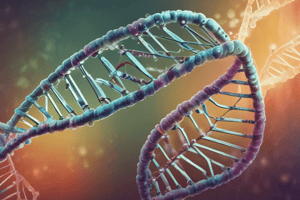Podcast
Questions and Answers
What is the approximate number of bases in one turn of B-DNA?
What is the approximate number of bases in one turn of B-DNA?
- 10.5 (correct)
- 12
- 10
- 15
What is the main difference between A-form and B-form DNA?
What is the main difference between A-form and B-form DNA?
- A-form is more common in GC-rich regions, while B-form is more common in AT-rich regions
- A-form has a right-handed helix, while B-form has a left-handed helix
- A-form is more compact, while B-form is more relaxed
- A-form is wider, while B-form is narrower (correct)
What is the role of histone amino terminal tails in chromatin compaction?
What is the role of histone amino terminal tails in chromatin compaction?
- They project inward and block chromatin compaction
- They can be modified to control gene transcription (correct)
- They project outward and facilitate chromatin compaction
- They are not involved in chromatin compaction
What is the approximate length of the repeat unit of a nucleosome?
What is the approximate length of the repeat unit of a nucleosome?
What is the function of the 10nm fibre in chromatin structure?
What is the function of the 10nm fibre in chromatin structure?
What is the role of DNA loops in gene regulation?
What is the role of DNA loops in gene regulation?
What is the function of CTCF binding sites in DNA loop formation?
What is the function of CTCF binding sites in DNA loop formation?
What is the relationship between chromatin and nucleosome?
What is the relationship between chromatin and nucleosome?
What is the role of histone tail modifications in chromatin compaction?
What is the role of histone tail modifications in chromatin compaction?
What is the function of chromatin remodelers in chromatin structure?
What is the function of chromatin remodelers in chromatin structure?
What is the significance of topologically associated domains (TADs)?
What is the significance of topologically associated domains (TADs)?
What is the role of SMC proteins in DNA loop formation?
What is the role of SMC proteins in DNA loop formation?
Flashcards are hidden until you start studying
Study Notes
DNA Structure
- DNA strands are joined by phosphodiester bonds
- Negatively charged phosphates face outwards
- One turn of the helix occurs every 10.5 bases in B-DNA
- The rise per base pair is 3.4Å, and the width of the helix is 20Å
- The rise per helical turn is 10.5 x 3.4Å
B-DNA and A-DNA
- B-DNA is the most common form, while dsRNA adopts the A form
- A-form is wider than B-form, with a more compressed major groove, wider minor groove, and tilted bases
- GC-rich DNA adopts the A form
Z-DNA
- Z-DNA is a left-handed DNA structure, with a phosphate backbone that follows a zigzag trajectory
Chromatin Structure
- Chromatin is formed by chromosomal DNA bound to proteins like histones and other DNA-packaging factors
- The basic unit of chromatin is the nucleosome
- The nucleosome core particle consists of a sequence of 146nt wrapped around a barrel-shaped octamer of histone in 1.7 turns of a left-handed superhelix
Histones
- Histones are positively charged
- The histone octamer of the NCP particle consists of 2 H2A-H2B dimers flanking a tetramer of 2 H3 and H4
- Amino-terminal tails of histones project and can be modified, leading to compaction of chromatin and control of gene transcription
Chromatin Fibre
- 10nm fibre is the most abundant chromatin form, with nucleosomes separated by linker DNA
- The repeat length of nucleosomes is 200nt
- 10nm fibre can transition to 30nm fibre (regular/compact form), with most folds being random
DNA Loop Formation
- DNA loops are the next stage in the organisation of DNA, anchored to a protein-chromosome scaffold
- DNA loops are segregated from the genome and bring enhancers and promoters together, playing an important role in gene regulation during development and differentiation
Structural Maintenance of Chromosomes (SMC) Proteins
- Cohesin and condensin are SMC proteins with split ATPase domains
- Two SMC proteins hinge dimerise to give a V-shape
- Role in DNA loop formation
- Cohesin and condensin heads are linked by a non-SMC subunit, forming a topological ring that traps DNA and forms a loop
Topologically Associated Domain (TAD)
- TAD is a constituent unit of chromosomal DNA at the Mb scale
- TAD is a separate transcriptional/topological entity
- TAD is formed by several DNA loops folding together
Chromosome Territory
- Chromosome territory is a unique volume occupied by each chromosome in the nucleus
- Chromosome territory is divided into compartments A and B
- Compartment A is euchromatin, while compartment B is heterochromatin
Chromatin Status
- Chromatin status is a dynamic state of chromatin (open/close etc.) and can be modified by the binding of H1, leading to compaction
- Post-translational modification of histone tails can also modify chromatin status
- Chromatin remodelers alter the position of nucleosomes
- Lysine acetylation to histone tails reduces overall positive charge, reducing chromatin compaction
- Histone tail modifications represent an epigenetic histone code, which is dynamic due to chromatin writer/eraser proteins
- Nucleosome remodelling shifts nucleosome position to allow availability of DNA-binding sites
Studying That Suits You
Use AI to generate personalized quizzes and flashcards to suit your learning preferences.




